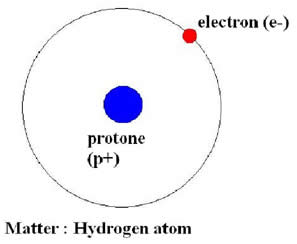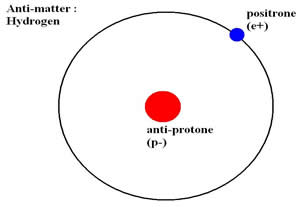Matter :
Our galaxy is made up of matter. In which all the atom in our galaxy, is made up of positively charged nueclius, and around it, negatively charged electrone.

Here, the figure of simplest atom of matter : Hydrogen is given.
Anti-matter :
Construction of atom of anti-matter is the same as the atom of matter. But it is also mirror image of atom of matter. Means, in anti-matter, charges of sub-atomic particles are changed.
In the nuclies of anti-matter, the charge is negative - anti-protone (p-).
And in the orbit, there is positive electone - positrone (e+).
The mass of anti-protone (in anti-matter) and protone (in matter) are equale.
The mass of positrone (in anti-matter) and electrone (in matter) are equale.

Here, the figure of simplest atom of antimatter : Hydrogen is given.
- If any how, matter and anti-mater of equale quanity are mixed together, both of them will get destroyed and all the mass of them will be converted into light energy.
- We cannot even touch the sample of anti-matter, because, if we touch it, our body can also be converted into energy.
- Our whole galaxy is made up of as we know, matter.
- So, how can we find any galaxy made from anti-matter ?
- The answer is : it is impossible to know.
- Because, we study other galaxies from light emitted from it. And photones emitted by matter galaxies and anti-matter galaxies are identicle.
The energy coming from the process of mixing matter and anti-matter is many -many times larger than energy coming from atomic power station.
Because, in atomic power station, only the depression of mass is converted into energy. And after process, we have many radioactive waste. So, only the small portion of mass is converted into energy. While in the above decribed process, all the mass is converted into energy according to the equation of Einstein : E = m*c*c .
You will get amazed after knowing that the whole universe contains just 2 to 5% of matter. So what is 95 to 97% part of the universe?
Dark-matter :
In our solar system, as we go far from the Sun, the orbital speed of planets around the Sun decreases.
If most of the mass in the Milky Way and the other galaxies resides in its stars, then astronomers would expece stars' orbital velocities to decreas for distances greater than the star's distance from the galactic center. Instead, as Vera Rubin and other astronomers found, the velocities of stars far from the centre, both in the Milky Way and other spiral galaxies, do not decrease significantly below the velocity with which the star orbits the center.
During the early 1970s, as Rubin studied details of these motions of stars, she obtained a remarkable result. Rubin showed that beyond the Sun's distance, the speed with which stars move in orbit remains nearly constant.

If most galaxies behave like the ones that Rubin has studied, then most of the matter (95 to 97%) in galaxies rasides in an unknown form and does not shine as stars do.
Astronomers at first reffered to this invisible, unknown matter as the "missing mass" that is, the mass whose existance had been deduced, but could not be seen. But the mass cannt be said to be "missing", (because it affects the orbital time of stars in the galaxies) since Vera Rubin and other had found it; its nature was all that was unknown.
By the 1980s the term "missing mass" had been replaced by the now-current term "dark-matter" which more accurately decribe it.